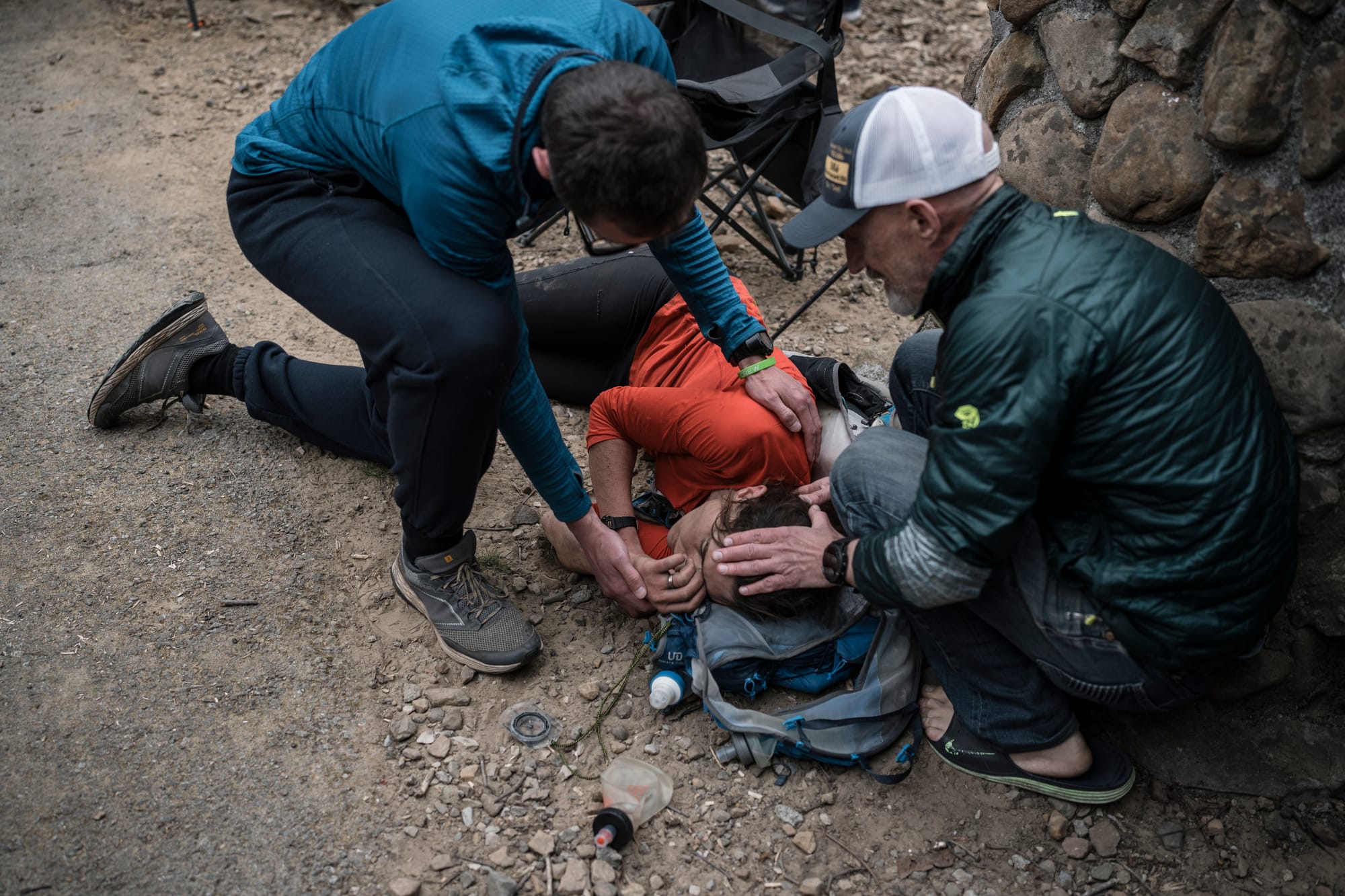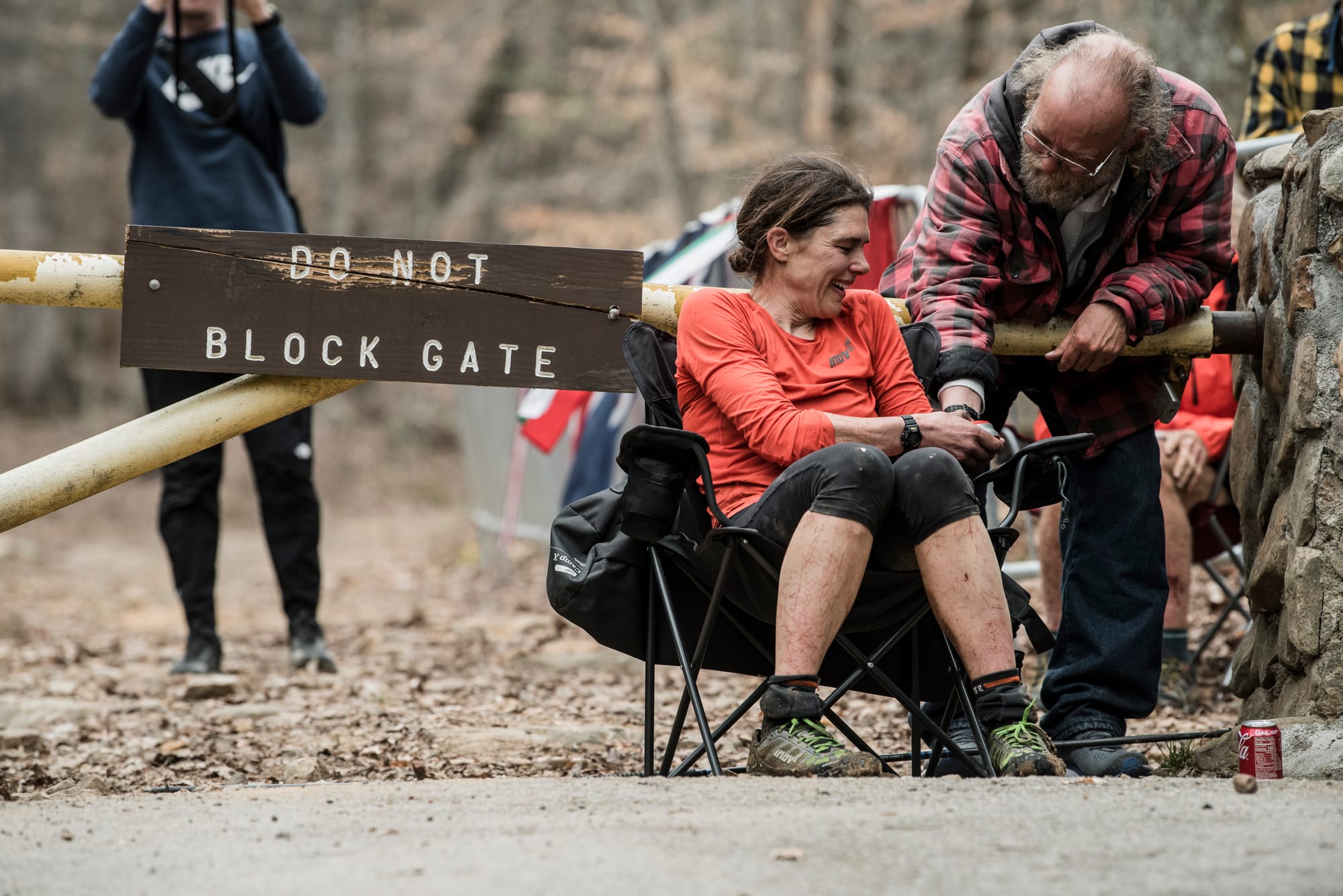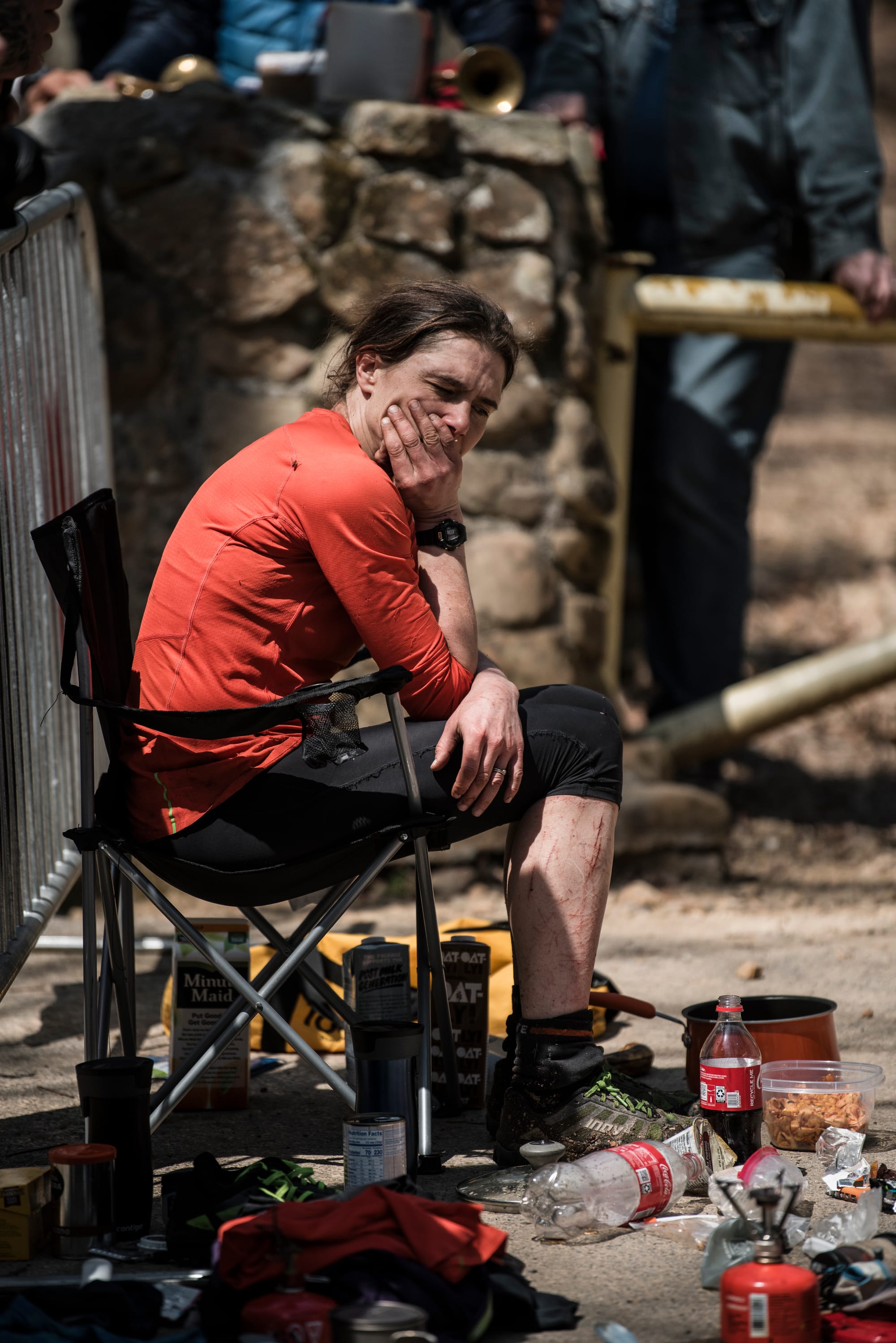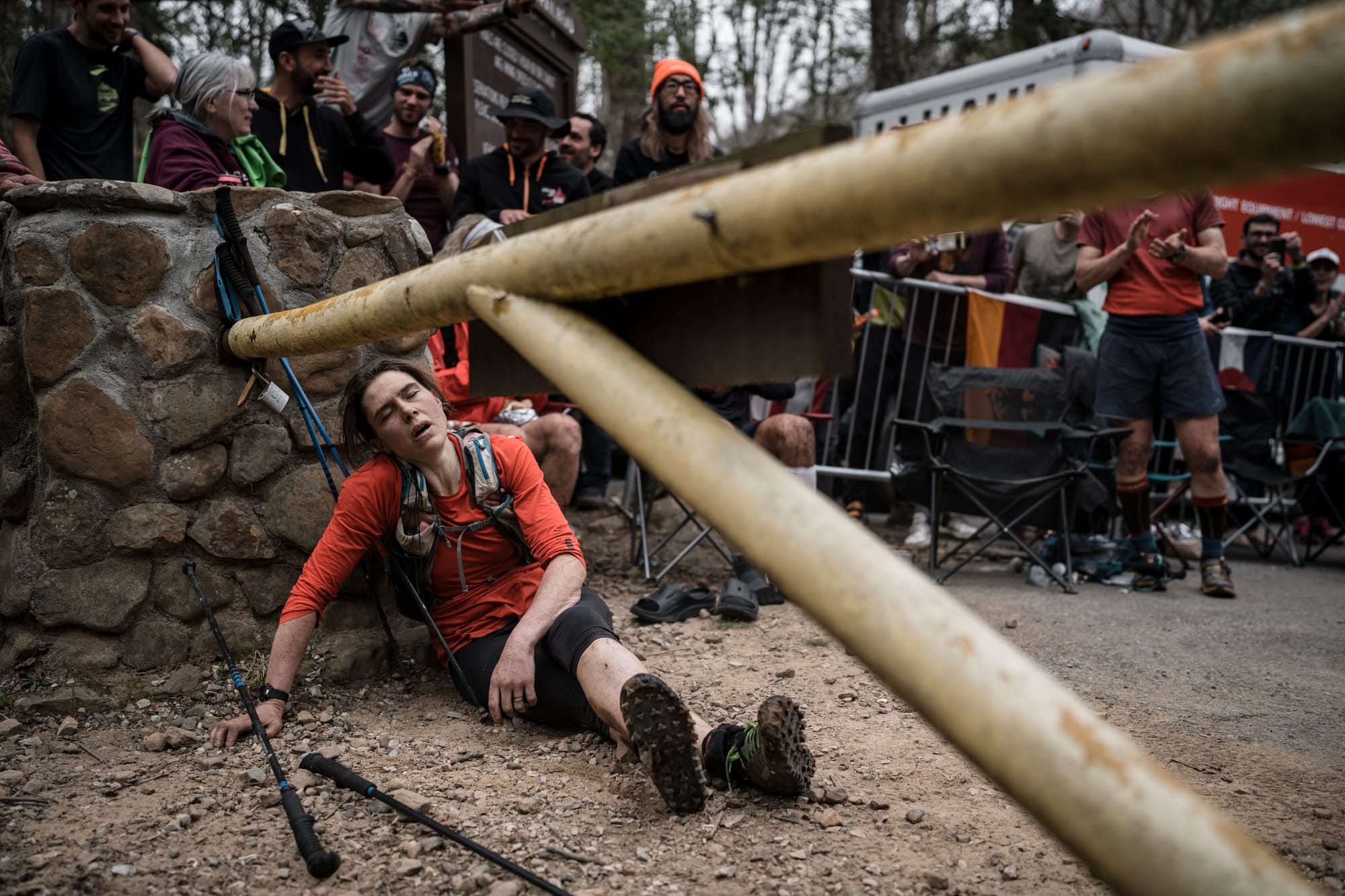It’s well past midnight and darkness engulfs every nook of Frozen Head State Park. Cicadas sing through the brush. Spiders weave webs in the branches. Bats fly under the light of the pale moon. Dead leaves crunch under Jasmin Paris’s feet as she slogs through the forest.
In most cases, this is exactly where Paris wants to be: in nature, enjoying the sounds, the smells, and the rhythms of the wilderness, where she feels most peaceful. But this particular night isn’t like most hikes she’s endured in her life. She’s been awake for more than two days, save for a three-minute nap. She’s only intermittently eaten, mostly bananas, rice pudding, pasta, or cheese-and-pickle sandwiches. And she’s pushing past her body’s cries to quit as she breaks through boundaries she never thought possible.


Jasmin Paris became obsessed with the Barkley Marathons, a masochistic marathon through the Tennessee wilderness known as the race that "eats its young." [Jacob Zocherman photos]
All this to complete a race through the vast Tennessee forest. But not just any race. A race so demanding it’s been dubbed the “race that eats its young.” A race that, in most years, there are no finishers. A race that is 100 miles long with an elevation gain equivalent to climbing Mt. Everest — twice. A race that, in its 38-year history, no woman has ever completed. A race known as the Barkley Marathons.
At this moment, some 50 hellish hours in, Paris has pushed farther than any woman in Barkley history by completing four 20-something-mile loops through the steep mountains, briars, and trees. She’s close to finishing but must maintain her strict schedule as she searches the vast forest for strategically placed books — pages, specifically — that serve as tokens proving she didn’t cheat her way through the course and into the Barkley records, where only 20 runners have ever finished.
Legs tired, body aching, mentally exhausted, Paris begins an ascent up a ridge in search for the next book, the next page, that will lead her to the finish line. Suddenly, it’s as if the forest goes quiet and goosebumps invade Paris’s pale skin. Ahead in the shadows she sees — or thinks she sees — five people dressed in black-hooded jackets slowly shuffling through the thicket as they climb the ridge.
Only Paris can’t be sure if what she’s seeing is real or a hallucination. Why are there five adults walking through the forest this late at night? Surely it’s her imagination…right? Then again, she watches so clearly as they climb ahead. What if they’re lost?
The foreboding scene fills Paris with fear, though she has no time to waste. There isn’t time to help the wandering, not when seconds are so precious. And she can’t avoid them and veer off track, adding distance to her race. If her math is correct, if she stays on pace, if she doesn’t get lost, and if she keeps pushing through the pain, she’ll cross the finish line with mere moments to spare. She must continue her brisk pace: past the shadowy figures, deep into the forest.
This isn’t the first time Paris has hallucinated in these woods. Last year during this same race, she swore she saw Dracula sitting on an iron throne. Her weary mind has conjured big cats and owls and horses. She once saw a man sleeping in the middle of a trail — only once she approached him, she realized it was a fellow competitor taking a brief snooze. At Barkley, sleep comes rarely, and you take it when you can.
“It’s incredible,” Paris admits, “how accurate your brain can conjure up a picture of something and how convinced you can be it’s there.”
This year marks Paris’s third attempt at finishing. She dropped out the previous two years, though she always felt confident she could complete all five loops. That determination comes from her parents: her dad is quite the competitor, and her mom is an endurance athlete in her own right. Mixed together and you get Paris, whose perfectionism and stubbornness mean she will do whatever it takes to complete something she sets her mind to.
After the 2023 race, Paris reached Barkley’s yellow gate with a wooden rectangular sign that reads “DO NOT BLOCK GATE”, home to the race’s start and finish line, after the cutoff time for completing the fourth loop. She spoke to Gary “Lazurus Lake” Cantrell, the founder and race director, and, despite her exhaustion, told him she would one day finish.

Laz is the brainchild behind Barkley. In his youth, he was an ultrarunner who conceived races aimed at pushing athletes to the extreme. He’s been called both an “evil genius” and a “bearded saint.” Now an older man in his 60s, he sports a thick, graying beard with thin glasses and directs one of the most difficult races in existence.
What makes Barkley so difficult isn’t just the mileage, the time, the terrain, or the bipolar weather. It’s also the mental hurdles competitors must overcome. No spectators are on the course, so no one is there to cheer you on when times are tough. No cell phones or GPS trackers are allowed, so you’re left relying on your navigational skills with a paper map. The course doesn’t follow established trails, so you must endure the cuts and scrapes and bruises of the trees and thorny bushes.
“To finish the Barkley,” Laz says in a 2021 documentary, “you have to really come physically in the best condition of your life, and mentally completely focused on the job at hand. And you have to be talented and really physically tough.
“There’s no way to describe the difficulty, physically and mentally, of continuing to go. And it’s not always the greatest fun in the world while you’re doing it. But when you get done — and when you look back on it — I got my 100. It took me five years. But that’s not a bad time at the Barkley.”
After 2023’s dropout, Paris immersed herself in training for the following year. She went to bed early to wake up at midnight to train in the Scottish hills, even if it meant climbing in the sleet and freezing temperatures. She focused on strength training to prevent muscle fatigue late in the race. She knew that if she stood a chance at finishing, she must feel her best after the third loop. She ran through her past failures, like losing her way in the dead of the night, and made mental notes of how to overcome them.
And that’s, perhaps, where Paris is at her best: making important decisions on the fly. It’s a skill that suits her well both as an endurance athlete and a veterinarian, where she specializes in working with small animals. Her brain works overtime in the operating room or during long hours in the clinic, where she faces decisions that can mean life or death. It makes all the stressors that come with ultrarunning feel a bit silly. There’s no life or death on the line during a race; only the pressure she puts on herself to finish.
But it’s those day-in-and-day-out decisions that train her brain for the moments during a race when she’s left with choices that will make or break a race.
“Being a vet and in the same way as Barkley, you constantly have these various setbacks thrown at you that you have to pick yourself up from, learn from, and work out a way around,” she says. “You have to be mentally resilient but also adaptable and learn on the fly.
After nearly 60 hours in the Tennessee woods, Paris breaks through the trees and her feet touch concrete for the final uphill stretch to the finish. Her arms, legs, and face are coated in dirt. Her lips are chapped. Her body screams in pain as her feet continue to march one in front of the other like the best-trained soldiers. A group of fans cheer as she marches on, though she’s too tired to hear. She touches the yellow gate before her body collapses onto the dirt path. She gasps — over and over and over — willing to give anything for one deep breath to fill her tired lungs. She can’t even open her eyes. A man rubs her shoulder. The crowd continues to cheer.
She’s pushed her body to levels she didn’t know were there, where she pulled out strength and grit and courage from a nearly depleted well. Is it enough to finish the Barkley Marathons in the allotted time?
Yes! Jasmin Paris finished all five hellish loops in 59 hours, 58 minutes, and 21 seconds — besting the 60-hour cutoff by a mere 99 seconds, a race record for the closest finish.

She had faith she would one day complete the masochistic marathon, the fact be damned that no woman prior had ever done so. She may not realize it lying on the dirt path begging for escape from the pain and exhaustion, but the hours training in the sleet and frigid temperatures, traversing past the foreboding figures in the forest, and digging into the deepest wells of her body is that they allowed her to push herself to her absolute limit. And while it took obsessing over the Barkley Marathons to get there, she’s unsure she’ll ever reach that deep again. That’s okay, though, because she knows one thing: there will be more races. And as she’s keen to say, “Until you try, you don’t know what’s possible.”
